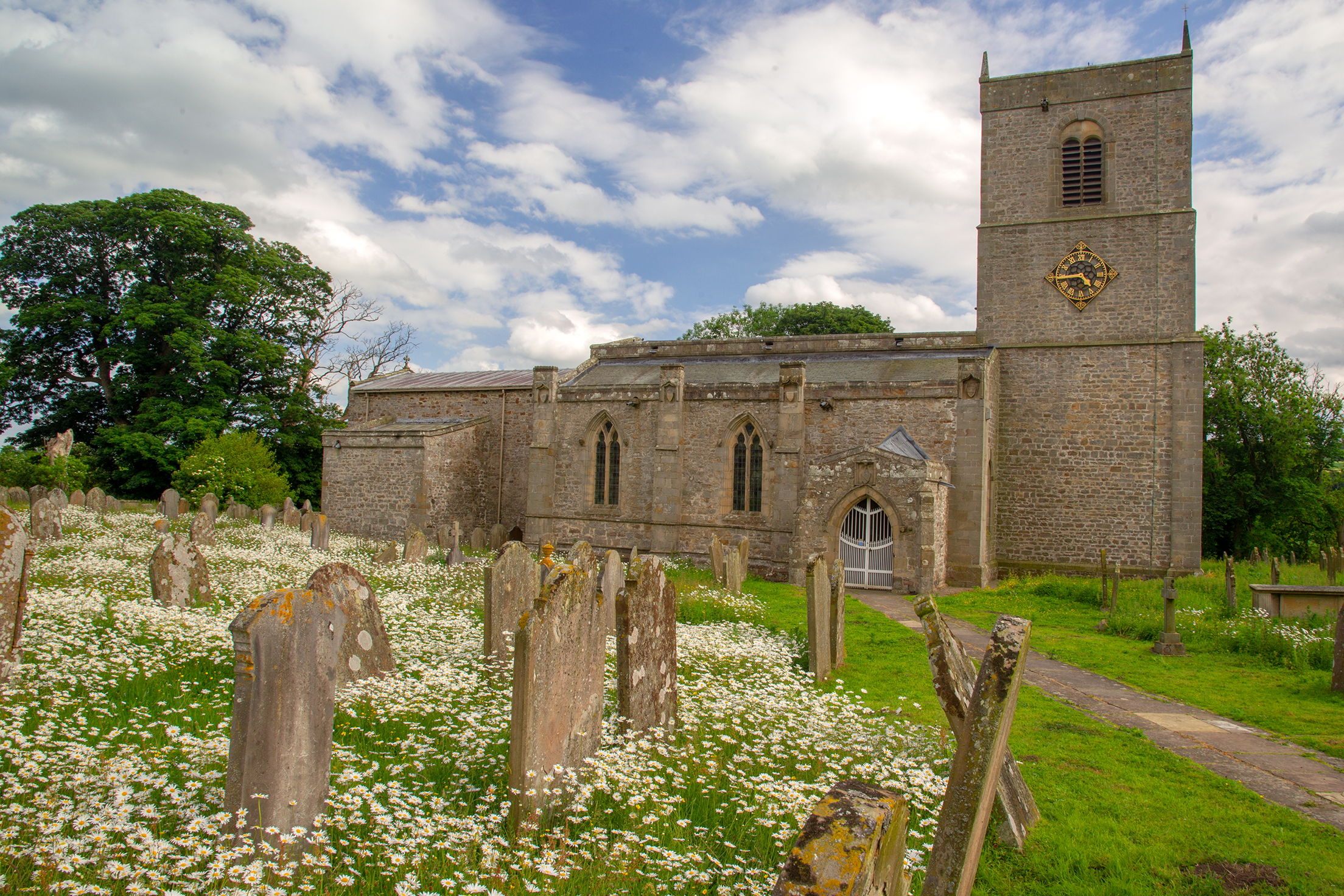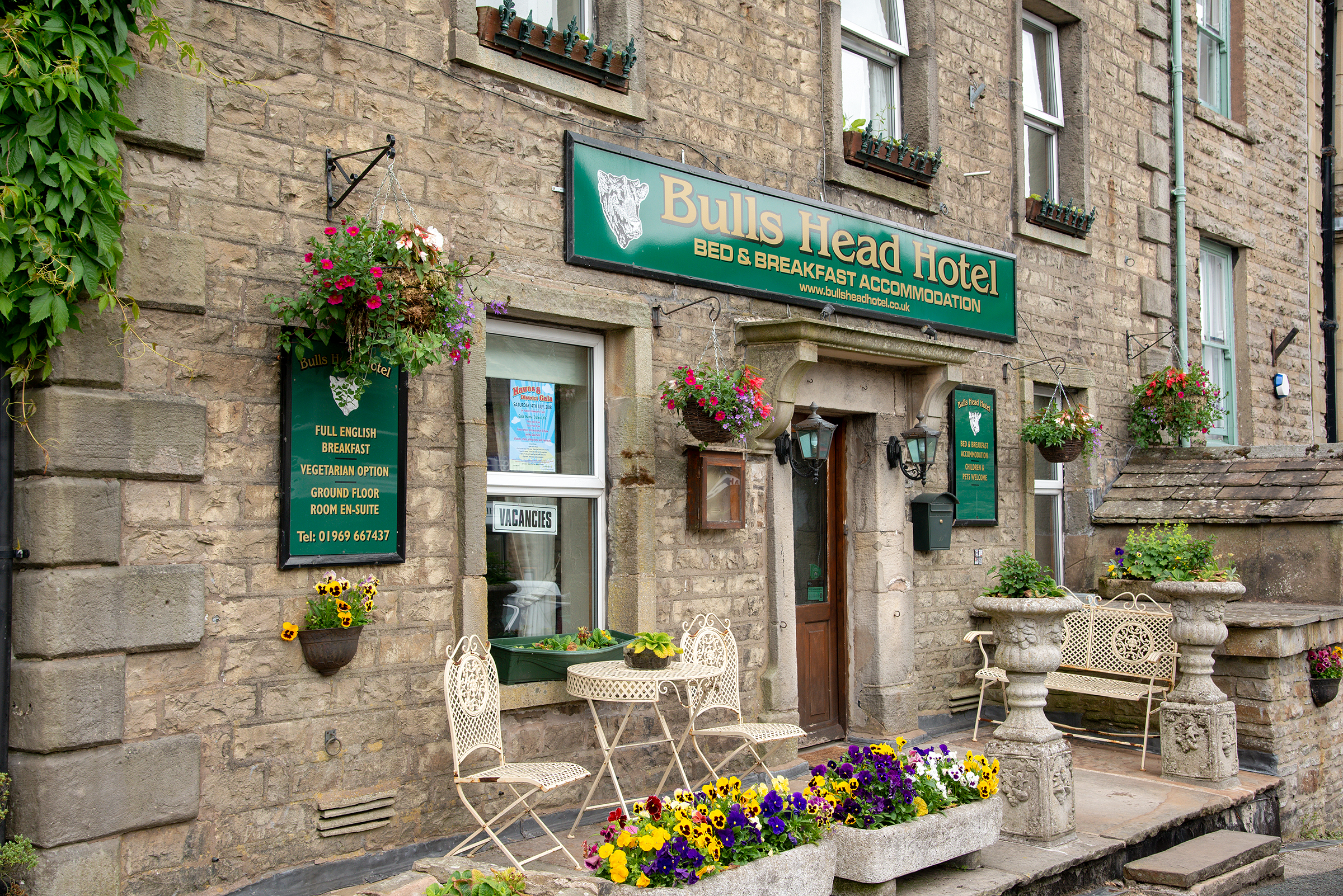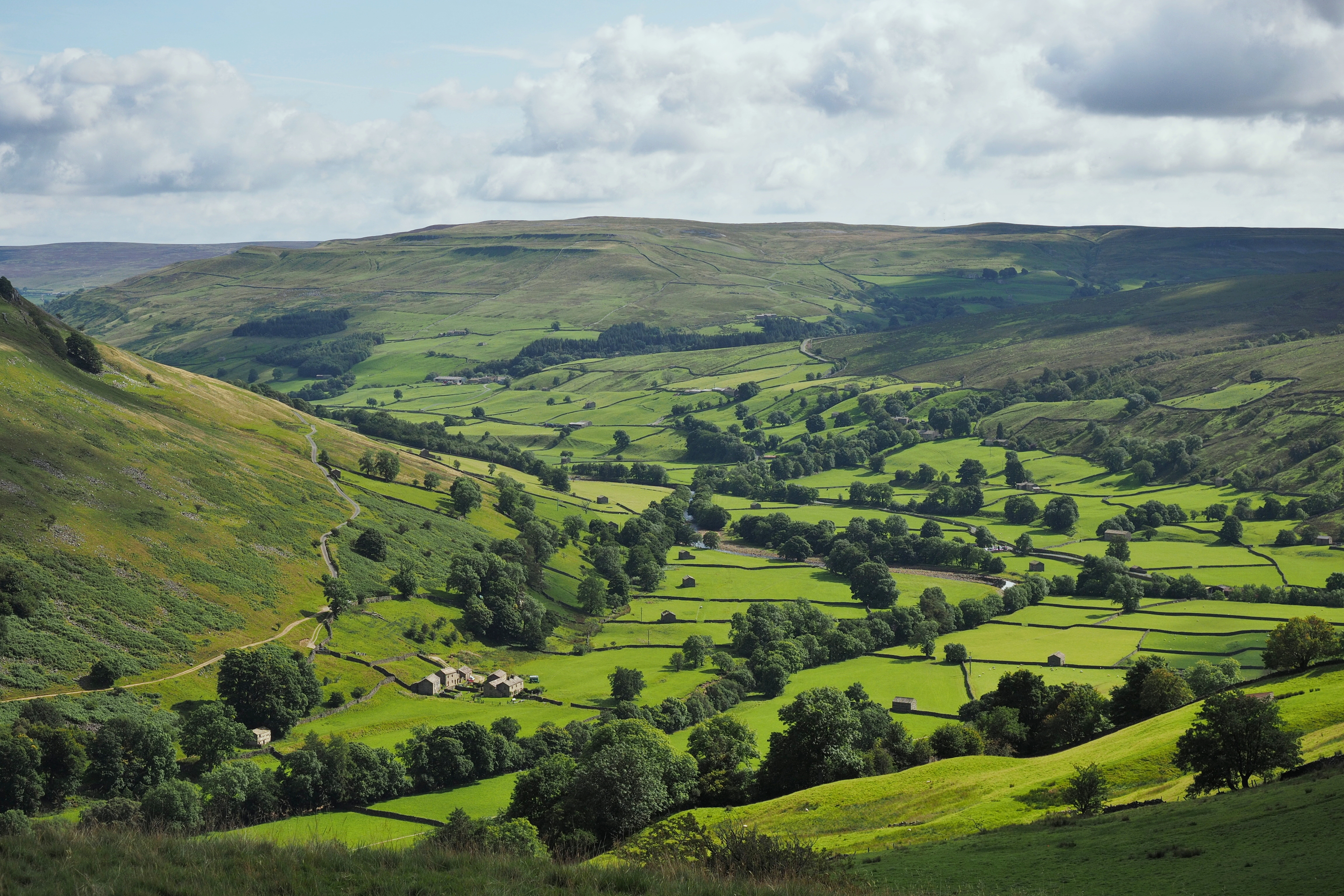|
Wensleydale
Wensleydale is a valley in North Yorkshire, England. It is one of the Yorkshire Dales, which are part of the Pennines. The Dale (landform), dale is named after the village of Wensley, North Yorkshire, Wensley, formerly the valley's market town. The principal river of the valley is the River Ure, Ure, which is the source of the alternative name Yoredale. The majority of the dale is within the Yorkshire Dales National Park; the part below East Witton is within the National Landscape, national landscape of Nidderdale Area of Outstanding Natural Beauty, Nidderdale. Addlebrough, at , dominates the landscape of the upper dale, and Penhill, at , is prominent in the lower dale. The dale lends its name to the Yoredale Series, Yoredale Group of Carboniferous rocks. The dale is famous for Wensleydale cheese, its cheese, with the main commercial production at Hawes. History At the time of the Domesday Book in 1086, Wensley included two berewicks [a portion of farmland], "one of 4 and ... [...More Info...] [...Related Items...] OR: [Wikipedia] [Google] [Baidu] |
Wensleydale Cheese
Wensleydale is a style of cheese originally produced in Wensleydale, North Yorkshire, England, but now mostly made in large commercial creameries throughout the United Kingdom. The term "Yorkshire Wensleydale" can only be used for cheese that is made in Wensleydale. The style of cheese originated from a monastery of French Cistercian monks who had settled in northern England, and continued to be produced by local farmers after the monastery was dissolved in 1540. Wensleydale cheese fell to low production in the early 1990s, but its popularity was revitalized by frequent references in the '' Wallace & Gromit'' series. Flavour and texture Wensleydale is a medium cheese that is supple and crumbly. It has a slight honey aroma. Common flavour combinations The flavour of Wensleydale is suited to combination with sweeter produce, such as sweet apples. Many restaurants and delicatessens serve a version of the cheese that contains cranberries. In Yorkshire and North East England, th ... [...More Info...] [...Related Items...] OR: [Wikipedia] [Google] [Baidu] |
Wensleydale
Wensleydale is a valley in North Yorkshire, England. It is one of the Yorkshire Dales, which are part of the Pennines. The Dale (landform), dale is named after the village of Wensley, North Yorkshire, Wensley, formerly the valley's market town. The principal river of the valley is the River Ure, Ure, which is the source of the alternative name Yoredale. The majority of the dale is within the Yorkshire Dales National Park; the part below East Witton is within the National Landscape, national landscape of Nidderdale Area of Outstanding Natural Beauty, Nidderdale. Addlebrough, at , dominates the landscape of the upper dale, and Penhill, at , is prominent in the lower dale. The dale lends its name to the Yoredale Series, Yoredale Group of Carboniferous rocks. The dale is famous for Wensleydale cheese, its cheese, with the main commercial production at Hawes. History At the time of the Domesday Book in 1086, Wensley included two berewicks [a portion of farmland], "one of 4 and ... [...More Info...] [...Related Items...] OR: [Wikipedia] [Google] [Baidu] |
Hawes
Hawes is a market town and civil parish in North Yorkshire, England, at the head of Wensleydale in the Yorkshire Dales, and historically in the North Riding of Yorkshire. The River Ure north of the town is a tourist attraction in the Yorkshire Dales National Park. The population in 2011 was 887. The parish of Hawes also includes the neighbouring hamlet of Gayle. Hawes is west of the county town of Northallerton. It is a major producer of Wensleydale cheese. Hawes has a non-profit group that seeks funding to re-open or keep community amenities. History There is no mention in the Domesday Book of 1086 of a settlement where the current town is. The area was historically part of the large ancient parish of Aysgarth in the North Riding of Yorkshire, and there is little mention of the town until the 15th century when the population had risen enough for a chapel of ease to be built. The settlement was first recorded in 1307 as having a marketplace. The place's name is deri ... [...More Info...] [...Related Items...] OR: [Wikipedia] [Google] [Baidu] |
Leyburn
Leyburn is a market town and civil parish in North Yorkshire, England, sitting above the northern bank of the River Ure in Wensleydale. Historic counties of England, Historically in the North Riding of Yorkshire, the name was derived from 'Ley' or 'Le' (clearing), and 'burn' (stream), meaning clearing by the stream. Leyburn had a population of 1,844 at the 2011 Census of the United Kingdom, 2001 census increasing to 2,183 at the 2011 Census. The estimated population in 2015 was 2,190. History Leyburn was mentioned in the Domesday Book of 1086 but had no recorded population. The much later growth of Leyburn as a major hub is linked to the decline in fortunes of nearby Wensley, North Yorkshire, Wensley, which had prominence as the only market town in Wensleydale; the village had received its Royal Charter in 1202 but declined dramatically after being devastated by the Black Death, plague in 1563. In fact, the once important and prosperous town was mostly abandoned. Leyburn's st ... [...More Info...] [...Related Items...] OR: [Wikipedia] [Google] [Baidu] |
Askrigg
Askrigg is a small village and civil parish in Wensleydale in the Yorkshire Dales National Park, part of the county of North Yorkshire, England. The village and its parish are located in Upper Wensleydale, west of Leyburn, and east of Hawes. It is west of the county town of Northallerton. History The village is mentioned in the Domesday Book as ''Ascric''. At the time of the Norman invasion the Manorialism, manor was held by Arnketil. Afterwards, the lands were owned on behalf of the Crown by Count Alan of Brittany, who granted then lordship of the manor to Gospatric'','' son of Arnketil. By 1251, the manor had come to the Fitz Hugh family who were also lords of Ravenworth and stayed with them until the 16th century. In the early 16th century, the manor became the possession of Sir Thomas Parr. His son William Parr, 1st Marquess of Northampton, William died without issue in 1571 when it became the property of the Crown. In 1664 the manorial rights were leased from the Crown ... [...More Info...] [...Related Items...] OR: [Wikipedia] [Google] [Baidu] |
River Ure
The River Ure in North Yorkshire, England, is about long from its source to the point where it becomes the River Ouse. It is the principal river of Wensleydale, which is the only major dale now named after a village rather than its river. The old name for the valley was Yoredale after the river that runs through it. The Ure is one of many rivers and waterways that drain the Dales into the River Ouse. Tributaries of the Ure include the River Swale and the River Skell. Name The earliest recorded name of the river is in about 1025, probably an error for , where represents the Old English letter wynn or 'w', standing for ("water"). By 1140 it is recorded as ''Jor'', hence Jervaulx (Jorvale) Abbey, and a little later as ''Yore''. In Tudor times, antiquarians John Leland and William Camden used the modern form of the name. The name probably means "the strong or swift river". This is on the assumption that the Brittonic name of the river was ''Isurā'', because the Ro ... [...More Info...] [...Related Items...] OR: [Wikipedia] [Google] [Baidu] |
Wensley, North Yorkshire
Wensley is a small village and civil parish in North Yorkshire, England. It consists of a few homes and holiday cottage, an inn, a pub and a historic church. It is on the A684 road south-west of the market town of Leyburn. The River Ure passes through the village. The etymology of the name ultimately originates either from a compound of an Old English form of the god Woden (attested ''Wednesleg'' 1212, earlier ''Wodnesleie'', see Wednesday), and the Old English ''leah'' meaning wood or meadow. Another possible route for the first part is the personal name ''Wændel''. Wensley gives its name to the dale Wensleydale. From 1974 to 2023 it was part of the district of Richmondshire, it is now administered by the unitary North Yorkshire Council. For a century after its charter in 1202, Wensley had the only market in the dale and this continued into the 16th century. Plague struck Wensley in 1563, some surviving villagers fled to Leyburn, but the village recovered a century later ... [...More Info...] [...Related Items...] OR: [Wikipedia] [Google] [Baidu] |
Yorkshire
Yorkshire ( ) is an area of Northern England which was History of Yorkshire, historically a county. Despite no longer being used for administration, Yorkshire retains a strong regional identity. The county was named after its county town, the city of York. The south-west of Yorkshire is densely populated, and includes the cities of Leeds, Sheffield, Bradford, Doncaster and Wakefield. The north and east of the county are more sparsely populated, however the north-east includes the southern part of the Teesside conurbation, and the port city of Kingston upon Hull is located in the south-east. York is located near the centre of the county. Yorkshire has a Yorkshire Coast, coastline to the North Sea to the east. The North York Moors occupy the north-east of the county, and the centre contains the Vale of Mowbray in the north and the Vale of York in the south. The west contains part of the Pennines, which form the Yorkshire Dales in the north-west. The county was historically borde ... [...More Info...] [...Related Items...] OR: [Wikipedia] [Google] [Baidu] |
Yorkshire Dales
The Yorkshire Dales are a series of valleys, or Dale (landform), dales, in the Pennines, an Highland, upland range in England. They are mostly located in the Ceremonial counties of England, ceremonial county of North Yorkshire, but extend into Cumbria and Lancashire; they are entirely within the Historic counties of England, historic boundaries of Yorkshire. The majority of the dales are within the Yorkshire Dales National Park, created in 1954. The exception is the area around Nidderdale, which forms the separate Nidderdale AONB, Nidderdale Area of Outstanding Natural Beauty. The landscape of the Yorkshire Dales consists of sheltered glacial valleys separated by exposed moorland. The predominant rock is Carboniferous Limestone, which is particularly visible in the south-west in features such as Malham Cove. It is overlain in many areas by the Yoredale Series of alternating weak shales and hard limestones and sandstones, which give the dales their characteristic 'stepped' appeara ... [...More Info...] [...Related Items...] OR: [Wikipedia] [Google] [Baidu] |
East Witton
East Witton is a village and civil parish in Wensleydale in North Yorkshire, England. It lies south of Leyburn. The western part of the parish is in the Yorkshire Dales National Park, and most of the eastern part is in the Nidderdale National Landscape. In 2011 the parish had a population of 246. The village lies at the mouth of Coverdale. The River Cover and the River Ure are on the northern boundary of the parish. The parish extends down Wensleydale east of the village and includes Jervaulx Abbey, from the village. To the west in Coverdale, the parish includes Braithwaite Hall, a 17th-century manor house owned by the National Trust, from the village. From 1974 to 2023 it was part of the district of Richmondshire. It is now administered by the unitary North Yorkshire Council. Richard Whiteley is buried in the village; he and his partner, Kathryn Apanowicz, lived there. History East Witton was originally known simply as Witton and was mentioned (as ''Witun'') i ... [...More Info...] [...Related Items...] OR: [Wikipedia] [Google] [Baidu] |
Penhill
Penhill ( high at the trig point, at Height of Hazely) is a prominent hill, south west of Leyburn, in the Pennines, North Yorkshire, England. It forms a ridge that commands the southern side of Wensleydale and the northern side of Coverdale. Its concave shape was formed during the last ice age, when glaciers carved Wensleydale into a U-shape. The summit plateau has a trig point, small tarns on the peat moor, and, visible from the valley floor, a beacon at its eastern end, part of the large network built to warn of a Spanish invasion. Penhill is accessed by public footpaths from the village of West Witton, by a bridleway from a minor road between West Witton and Melmerby, or over open access land from the south. Although Penhill is not a very high hill, its position near the mouth of Wensleydale makes it visible from a considerable distance - from the North York Moors across the Vale of York, as well as from many points in the dale. Like Pendle Hill, Penhill is a ple ... [...More Info...] [...Related Items...] OR: [Wikipedia] [Google] [Baidu] |
Nappa Hall
Nappa Hall is a fortified manor house in Wensleydale, North Yorkshire, England, described by English Heritage as "probably the finest and least-spoilt fortified manor house in the north of England". It stands east of Askrigg, overlooking pastures leading down to the River Ure. A single-storey central hall sits between two towers, a four-storey western tower and a two-storey eastern tower. The four-storey tower has a turret, lit by slit vents, for a spiral staircase that climbs to crenellated parapets. The taller tower retains its original windows, but sash windows were inserted in the 18th century in the lower two-storey block which housed the kitchen and service rooms, at the opposite end of the hall. In the 17th century, an extra wing was added. The battlements are served by a single stair consisting of 70 stone steps. Nappa Hall is a Grade I listed building. Descent The place name Nappa, first mentioned in about 1251 as ''Nappay'', is of uncertain origin, but possibly ... [...More Info...] [...Related Items...] OR: [Wikipedia] [Google] [Baidu] |




